Supporting materials
issue11_pollen_electricity.pdf
Download
Download this article as a PDF

Teaching science at primary school can be a challenge. At La main à la pâte, Samuel Lellouch and David Jasmin send university students to support primary-school teachers. Why not try two of their activities in your classroom?
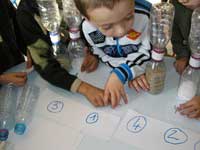
Guillermo is an engineering student at the prestigious Ecole Polytechnique in Saint Etienne, France. He is supporting Pascale, a teacher delivering a unit on electricity to six-year-olds (French CP level) in a local primary school. At the end of the class, they review the activities:
“Have you seen the diagrams the children made today? Their progress is amazing!” comments Pascale. “Next week we’ll learn about the switch. Can you come and help? It would be great if we could work together again.”
“Sure. I can provide diagrams, help you prepare the materials and guide the children’s ideas,” says Guillermo. “The switch is quite a difficult topic for six-year-olds. Perhaps we could introduce it by asking them how they could turn off a light bulb without disconnecting the wires.”
As part of a project called La main à la pâtew1, between 1500 and 2000 science or engineering students in France coach primary-school classes (children aged 3-11) during science lessons. The project was launched in 1996 by physics Nobel Prize winner Georges Charpak and the Académie des Sciences to promote investigation and inquiry-based science teaching in primary schools. Although it began in France, the project now runs in more than 20 partner countries. There are La main à la pâte mirror websites in Germanw2, Spanishw3, Serbianw4, Arabicw5 and Chinesew6, as well as an international web portal, Teaching Sciencew7. With versions in English, French and Spanish, this portal includes links to many of La main à la pâte’s partner projects in countries such as Belgium, Sweden, Turkey and Switzerland.
While an inquiry-based approach makes science more enjoyable for children, as well as helping them develop important skills and acquire scientific knowledge, it can be time-consuming. Particularly at first, preparing and running the sessions can be a lot of work: finding materials, organising experimental work, and guiding individual groups or children. Moreover, many primary-school teachers do not feel confident enough to run scientific activities in lessons.
Students like Guillermo help overcome such difficulties. Coming from engineering schools, technical universities and university science departments all over France, they volunteer to help teachers use an inquiry-based approach in the classroom. For at least seven consecutive weeks, third-year students spend half a day per week at a primary school. Each student helps a teacher to prepare the lesson – finding materials, preparing handouts, and setting up the experiments, as well as helping with the scientific concepts and knowledge. The teacher remains in charge of the lesson, and the student supports both the teacher and the children throughout the inquiry process. Once the lesson is over, the student and teacher analyse it together.
To allow more students and teachers to participate in such partnerships, as of 2009 the French ministry of education and ministry of research and higher education have joined this project, developing it into ASTEPw8: supporting teachers through the involvement of scientists in primary education.
Furthermore, La main à la pâte is the French co-ordinator of the European Pollen projectw9 (see box), which also promotes an inquiry-based approach, but with a stronger emphasis on community participation. Saint-Etienne, the French Pollen seed city, has concentrated on strengthening the links between primary schools and its university. Based on this experience, they have created a guide and a training unit for scientists and teachers, both of which are available online in French and Englishw10.
The children learn about their own abilities to perform scientific experiments, and have the opportunity to compare their approach with that of a ‘real’ science student. In addition, the inquiry-based approach allows children to enjoy teamwork as well as the experimental activities themselves: this is a real source of motivation and shared joy.
The primary-school teachers may realise that science is not as difficult as they thought and, with the students’ coaching, they can familiarise themselves with inquiry-based approaches similar to those used in scientific research. This is especially important because these teachers are more often trained in arts than in science – according to the French ministry of education, 80% of primary-school teachers do not have a scientific background. It is also satisfying for teachers to see how motivated and concentrated the children are in a concrete experimental situation.
The science and engineering students have the opportunity to give children a realistic idea of their job in particular and of science in general, while at the same time gaining an interesting insight into the world of teaching. Moreover, they face the sometimes difficult task of adapting their knowledge to a particular audience: children aged 3-11 can cause disconcerting situations, posing a real challenge to the students.
Pollen is a European project which aims to stimulate and support inquiry-based science education in European primary schools. Within the project, 12 seed cities for science in 12 EU countries have been selected to involve the whole community (including families, scientific partners, city halls, and cultural centres) in enhancing science teaching at primary-school level.
Teachers and scientists outside seed cities can get involved by forming local partnerships to become part of Pollen. They can also contribute to the online resourcesw9, which are freely available.
Below are two teaching activities developed by teachers and students involved in the La main à la pâte and Pollen projects. Details of many more activities are available on the La main à la pâtew1 and Pollenw9 websites.
This activity, discussed by Pascale and Guillermo, is a teaching unit in six sessions to introduce the notion of the electric switch to children aged 3-6w11. It can provide some ideas for teaching children about electricity, a topic that is often neglected in primary schools because teachers find it difficult to know how to approach it in class.
In the next section you will find the basic background knowledge required for the teacher and the class to work on this unit, while subsequent sections outline the activity itself. Further background information developed by La main à la pâte for teaching electricity at primary-school level can be downloaded from the Science in School websitew12.
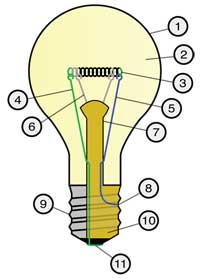
The key is to know what a simple electric circuit is. It consists of a continuous series of conductive objects, including a battery, electric cables and a light bulb. All these objects must be in contact with each other, one after the other, forming a closed loop – an uninterrupted circuit. Of course you can’t see what’s inside the battery, and it’s dangerous to take it apart since it will generally contain harmful chemicals, but a functioning battery is built to ensure circuit continuity, allowing electricity to flow. If the circuit is cut at some point, the battery can no longer ensure the flow of electricity.
To understand that the circuit really forms a loop, the class can initially take a close look at a light bulb without a socket and with broken glass. They can see that it contains two different contacts (the base contact and the electrical foot contact; see image), and they can then trace the path followed by the electricity from one of the contacts through the filament to the other contact.
Unfortunately, at primary-school level there is no experiment to visualise which direction the electricity flows in, since you’d have to be able to watch the tiny electrons. The important thing at this level is that electricity can move only if the circuit contains a working battery and forms a closed loop. How do you know if electricity is flowing through the circuit? At primary-school level, the only way is to see if a light bulb in this circuit is glowing or not.
If electricity is flowing through the circuit, the electrical current will travel through the filament; because of the filament’s electrical resistance, it will become white-hot and generate light and heat. The filament is always inside a glass receptacle containing a vacuum or an inert (noble) gas, to prevent it from reacting with the oxygen in the air (i.e., burning).
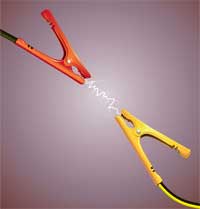

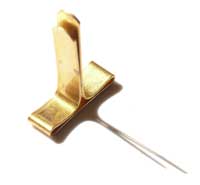
When introducing the switch, the main thing is that pupils understand that it is a moveable element of an electric circuit which, depending on its position, can either ensure or interrupt the continuous flow of electricity. Once this concept has been established, any item which fulfils this function is a valid switch, even if it’s only a paperclip with two split pins (see images above and left), or – for smaller children – a crocodile clip (see image above) with which they can open and close the simple electric circuit they made.
The electrical supplies can be purchased from local material companies, if they’re not yet available at the school.
Each step takes about 45 minutes. The following is just a proposed summary of the teaching unit. The pupils should focus on a familiar object to begin with, starting with a real-life use of battery and bulb, such as a pocket torch. After that, they can work in a more formal way with a battery and a bulb as a model for that object.
Step 1
Step 2
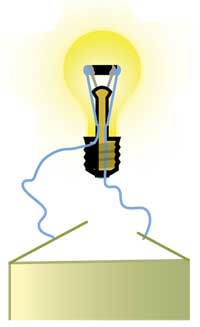
Discuss with the pupils: How can the bulb be switched on and off outside the torch?
Step 3
Step 4
Step 5
Step 6
Step 7
Below is a selection of activities from one of the Pollen teaching units. This teaching unit for pupils aged 3-6 deals with two essential quantities in physics: time and speed (for a more complex notion of ‘time’, see Al-Khalili, 2009). It enables the children to familiarise themselves with ideas such as ‘faster than’, ‘slower than’ and ‘at the same time as’. This teaching unit focuses on the inquiry-based method of experiment and discussion, and in it children study, use, produce and compare sand timers. They also learn to make the connection between the volume of sand (or in this case, semolina) in a sand timer and the timer’s running time. To view the whole unit, visit the Pollen websitew13.
Note: For some of the exercises, the pupils themselves must fill the sand timers and glue the two bottles together (see parts III and IV).
Materials for each group of four pupils
Three plastic bottle sand timers filled with three different levels of semolina and marked in different colours: red for the emptiest, blue for the middle one, and black for the fullest.
| 1st | 2nd | 3rd |
|---|---|---|
| x | x | x |
| x | x | x |
| x | x | x |
| OO > X | OOO > X | O > X |
Table 3: Example of a worksheet to note down expected results for three sand timers and the results
Group: Chloé, Marion and Maureen
Fill all of the sand timers correctly and arrange them from the fastest to the slowest.
The results I expect
| 1st | 2nd | 3rd |
|---|---|---|
| x | x | x |
| 0 | 00 | 000 |
The actual results
| 1st | 2nd | 3rd |
|---|---|---|
| x | x | x |
Inspectors aside, outside visitors are welcome in school science lessons – in addition to being a fresh face, they can bring another kind of expertise to bear. Undergraduate science students have a good chance of relating to schoolchildren simply by virtue of not being the regular class teacher. University students can also be a powerful antidote to the ‘boffin’ stereotype, at a time when formative attitudes to science in general and scientists in particular are being developed. A visiting university student would be welcomed too by the teacher, who in primary schools is unlikely to have a science background him/herself. The visitor will be someone who can probably make the experiments work, and has a better chance of dealing adequately with the awkward science questions pupils are likely to supply!
Numerous organisations are keen to involve schoolchildren under their understanding of science mandate. Hopefully this article will encourage you to make contact so that soon you will also be welcoming these visitors into your classrooms, through initiatives such as the European-wide Pollen project or their national equivalent, for example the ‘Researchers in Residence’ scheme or ‘Student Associates’ scheme in the UK.
The article details two hands-on investigative activities suitable for most primary-school science classrooms. One is about electricity, often not covered in primary schools using practical work; the other is about fair testing and good experimental technique. The first may include apparatus less commonly found as class sets in primary schools. The sand timer activity makes good use of a simple homemade piece of apparatus, enabling a variety of questions to be asked and predictions tested. Both activities are highly suitable for ‘how and why’ discussions with school pupils. They have been tried and tested with the help of university students in the classroom, and their successful deployment should encourage primary-school teachers to try a more investigative hands-on approach to science lessons – either with or without visiting help.
Ian Francis, UK
issue11_pollen_electricity.pdf
Download this article as a PDF